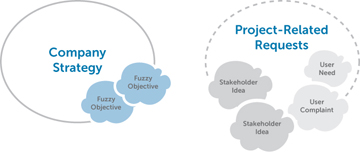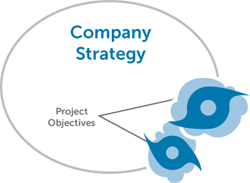Рассматриваем образующие цели для вашего проекта и вопросы, которые помогут укрепить эти цели. Вы также узнаете некоторые общие подходы / методологии и как они моугт повлиять на работу.
Читать обязательно: http://www.peachpit.com/articles/article.aspx?p=1856033


Читать обязательно: http://www.peachpit.com/articles/article.aspx?p=1856033
You’re in the project kickoff, with the full team for the first time. The project manager hands out some materials and gives you an overview of the project. By the end of the meeting, ideally, you should have the following information:
- Why is the project important to the company?
- How will stakeholders determine if the project was a success?
- What approach or methodology will the project follow?
- What are the major dates or milestones for key points, such as getting approval from business stakeholders?
All of these questions concern the expectations that stakeholders have for the project: whatthe project will accomplish and how they will be involved in it. The first two questions pertain to the project’s objectives and the last two to the project’s approach.
A project objective is a statement of a measurable goal for the project. Let’s talk about objectives in more detail.
Solidify Project Objectives
Objectives are an important focusing lens that you’ll use throughout the project. They should spring from the client company’s overall business strategy, so the project objectives should be in line with the strategic initiatives within the company. For example, if there is a strategic initiative to appeal to a new group of prospective customers (called a market), the site or application you’re creating may be an effort to provide that market with online access to products and services relevant to them. The objective for that project would then be focused on reaching and engaging that market.
A clear objective resonates throughout a project. It helps you:
- Ask the right questions as you gather ideas from business stakeholders
- Plan research with users and focus your analysis of the results
- Detail the ideas gathered from stakeholders and users and convert them into a consolidated list of project requirements
- Prioritize those project requirements based on their value to the company
- Create effective interaction designs
- Manage requests for changes to the design once development begins
- Focus efforts during deployment activities (such as training and communications to users about the new site or application before and during its launch)
- Determine whether you’ve met the needs of the client company, once the project is launched
When you start a new project, you probably have project objectives from the project’s sponsor (the business stakeholder who has direct responsibility for the success of the project), as well as a set of project-related requests coming from business stakeholders and from customers, but they all may be a bit fuzzy (Figure 4.1). Your goal is to clarify these into solid statements that you can use as a yardstick for the project’s success.

Figure 4.1 Fuzzy objectives, ideas, and needs
A solid objective has the following characteristics:
- Easy to understand. Avoid insider terminology
- Distinct. Avoid vague statements; instead, use wording that seems like it will be useful when you’re prioritizing requirements
- Measurable. Make concrete statements that you can set an independent measurement against to determine your success
As you define a fuzzy objective, making it clear and measurable, it becomes a solid objective that you can base decisions on (Figure 4.2 on the next page).

Figure 4.2 Objectives being solidified
You’ll hear many statements that could be considered objectives. Analyzing fuzzy ones such as those below will help you solidify your objectives and communicate more effectively within the project team.
This is an objective for the entire company, but is too broad for a specific project. Multiple initiatives at the company need to come together to make this happen; any one site or application may help with this but will be very unlikely to be able to handle the entire burden—unless the entire company is about this one site or application and it ends up being wildly successful.
This one is better, because a site or application could have an impact on this, but it’s still too vague. Why is it important to generate excitement? How does that excitement translate into meeting a business need? And how can you tell if you’ve been successful?
Now we’re getting there. This one is easy to measure, but it’s too focused on an intermediate step. Suppose you do generate more traffic: It may not help you if people don’t perform the actions you want once they get there.
Each of these can be measured and affected by your project. They can also map pretty closely to your designs and the features offered. For example, it’s very common to offer an online newsletter as a way to meet an objective of growing the customer database: To deliver the newsletter you’ll need to capture customer e-mail addresses, which will be added to the database. Objectives may also bring out new requirements. For example, if you’re measuring success by the average rating given to articles on your site, you’ll need a feature that allows users to give ratings. In these ways, objectives help you focus as you gather ideas for the site, and these may later become project requirements.
If there are multiple objectives, be sure to create a prioritized list with your business sponsor and project team. Objectives sometimes conflict with each other during design, and the team will need to know what takes precedence. The final prioritized list of objectives should come from your project sponsor, but you can be a key part of the discussion. Let’s talk about how.
How Can a UX Designer Help?
If you find the project objectives are unclear at the beginning of a project, you can bring your facilitation skills to bear. Help the project team understand the business-related context of the project by holding a workshop with key stakeholders (see the next chapter for more on identifying the right stakeholders). Your goal in this session, which usually lasts two to four hours, is to bring out information on the company’s strengths, weaknesses, opportunities, and threats. Called a SWOT analysis, this is a common business analysis technique and one way to discuss a company’s position in the market. You can also use this time to discuss the company’s competition.
Understand Strengths and Weaknesses
The SW in a SWOT analysis are the company’s current strengths and weaknesses as they pertain to the project. Strengths and weaknesses could include internal processes as well as external perceptions—and often they influence each other. For example, a company with a large research and development (R&D) department could have access to a large source of original research that is published (a strength), but there may be no one to help make that content more accessible to the average user, leading to the perception that the company is “too academic” (a weakness).
Identify Opportunities and Threats
The OT is the future-facing half of the SWOT. Considering the things that differentiate the company from its competitors, what future initiatives could it pursue that will open up a new niche or strengthen a current one? What situations could threaten those plans?
For example, our R&D company may decide to hire writers to publish more accessible feature articles around its original research (an opportunity), but if the current site toolset doesn’t have robust content-management features, the publishing process may be prohibitively slow. That could give competitors a chance to respond more quickly (a threat).
Compare Competitors
What is the company’s main competition? Who are the competitors for the site being developed? They can be different, especially for large companies or brand new sites.
Are there sites that aren’t necessarily direct competitors but that represent interesting models to consider? You can learn a lot from reviewing other e-commerce sites to see whether and how they sell what you’re selling.
Pull It Together
SWOT and competitors are good topics to discuss at the same time because they interact with each other. It’s hard to talk about future threats without knowing who your competitors are—and once you start talking about future opportunities, new competitors may come to mind.
Once you have a full picture here of the company’s competitors and SWOT, your project objectives—as well as the overall fit of your project within the company strategy—should become easier to define, and the priorities among them should become clear.
Solidifying project objectives helps you understand expectations of what the project is going to accomplish. Next, let’s talk about expectations concerning how the project will be run. Understanding the project approach will help you collaborate effectively and involve the right people at the right time.




Комментариев нет:
Отправить комментарий